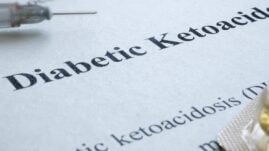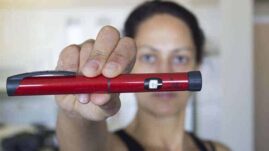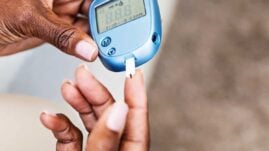Diabetic ketoacidosis, or DKA for short, is a severe complication of type 1 diabetes. If not treated quickly, it can lead to serious long-term complications like brain swelling and coma and can potentially even be life-threatening.
Despite its seriousness, many people do not know the signs and symptoms of DKA.
We sat down with Ty Beringer, who has lived with type 1 diabetes for 28 years and lives outside of Fayetteville, Arkansas. He experienced this condition firsthand.

Table of Contents
- What led to your DKA experience?
- Did you experience any warning signs that you were going into DKA?
- How was it treated?
- What do you know now that you wish you knew then?
- How has this affected you emotionally? How have you coped?
- Have you had any long-lasting physical impacts from DKA?
- Do you have any words of advice for others to avoid DKA?
- Final thoughts
What led to your DKA experience?
DKA develops when someone’s blood sugar remains dangerously high for an extended period.
This condition is often worsened by dehydration, leading to a buildup of acidic and toxic substances in the blood. Once DKA sets in, reducing blood sugar levels to safe levels becomes difficult.
People may experience DKA for different reasons. Nearly half of people with type 1 diabetes are in DKA at diagnosis, but acute circumstances like infection, illness, and even gaps in health insurance coverage (which can lead to insulin rationing) can lead to high blood sugar levels and resulting DKA.
Learn more in: What Is Diabetic Ketoacidosis?
Beringer highlights these issues vividly:
“My DKA experience was a direct result of the high price of insulin. At the time, I didn’t know there was a term for it, but I began lightly rationing my insulin during college. The rationing got worse in the year or so after I graduated. I was terrified of running out of insulin and terrified of low blood sugar because I worked by myself.”
He continues,
“These things, paired with the fact that my insurance company kept denying me access to a continuous glucose monitor, meant that I had no idea how much damage I was doing to my body. Eventually, it caught up to me and I spent a few nights in the hospital.”
Did you experience any warning signs that you were going into DKA?
While the signs and symptoms of high blood sugar — such as thirst, frequent urination, and weight loss — are well-known, detecting the onset of DKA can be challenging, particularly when you’re already feeling weak and unwell from elevated blood sugar levels.
Read more about high blood sugar symptoms in: Symptoms of High Blood Sugar (Hyperglycemia).
Beringer agrees that not everyone can see or feel it coming:
“The warning signs of DKA are pretty similar to that of someone intentionally not using enough insulin, so anyone who is rationing might not see it coming. I remember the day before I went to the hospital, I was incredibly thirsty and nauseous. The next morning, I couldn’t keep anything down and that’s when I knew I needed to go to the hospital.”
According to the U.S. Centers for Disease Control and Prevention (CDC), signs of DKA may include:
- Nausea
- Vomiting
- Fast, deep breathing
- Dry skin and mouth
- Flushed face
- Extreme thirst
- Frequent urination
- Rapid weight loss
- Fruity-smelling breath
- Blurry vision
- Headache
- Exhaustion
- Muscle aches
If you’re experiencing any of the aforementioned symptoms for days or weeks without improvement, seek emergency medical attention immediately or call 911.
How was it treated?
The treatment for DKA typically involves a combination of administered insulin and intravenous fluids. Patients must be closely monitored to ensure that their blood sugar levels are reduced at a controlled rate to avoid further complications.
Beringer shares his personal experience with the treatment:
“Hospitals are notorious for not knowing how to handle a patient with type 1 diabetes. However, I got lucky. I was put in the ICU and my nurse happened to be pretty familiar with T1D. My memory of my hospital stay is a bit spotty, but I know they ran lots of tests and put me on an IV. I was extremely dehydrated and went through multiple IV bags before I wasn’t thirsty anymore. I’m not sure what else they did — I was pretty out of it.”
The balancing act of type 1 diabetes can be extremely difficult, especially for young people. Some people with type 1 will experience DKA a few or even many times.
Beringer says,
“I’m not sure how many times I’ve had DKA, to be honest. I believe I went to the hospital a few times as a child. Those times were just because it’s hard to manage T1D in a kid, especially before we had access to the technology of today. I am also certain that I went into DKA a few times in college, but managed to get myself through it without going to the hospital — not something I would recommend.”
(If you believe you may be experiencing DKA, seek emergency medical attention immediately.)
What do you know now that you wish you knew then?
Beringer states,
“I wish I had known about the diabetes online community. Since then, I’ve seen other diabetics online helping out folks who are in the same situation I was in. They’re doing everything from advising diabetics on how to get a CGM to providing direct mutual aid. At the time, I was not interested in a diabetic community, so I cut myself off from the resources available to me.”
How has this affected you emotionally? How have you coped?
Having diabetes can be a rollercoaster of emotions. The CDC estimates that people with diabetes are two to three times more likely to have depression, and 20 percent more likely to have anxiety during their lifetime. The threat of DKA can contribute to that.”
Beringer says,
“For a long time, I was hard on myself, but I’ve since accepted that I was in survival mode and just trying my best to exist in my circumstances. I now take things much more seriously and don’t risk my health.”
He continues,
“But the biggest impact is that my DKA experience inspired me to become an advocate. I realized that if someone has as much privilege as I — a straight, white, man — have and still can be failed by the healthcare system, then none of us are safe and we need to do something about it. DKA as a result of rationing shouldn’t happen. I reflect on my experience with DKA every day and hope that it can ultimately have a positive impact on the world through my advocacy work.”
Have you had any long-lasting physical impacts from DKA?
Beringer notes,
“It’s hard to say what is a result of DKA or just a result of nearly 30 years with T1D. After my DKA experience, I got my act together, got a CGM, and cut my A1c [a measure of glucose control over the previous 2 to 3 months] in half. There were some temporary negative side effects from lowering my A1c so quickly, but those have gone away.”
Do you have any words of advice for others to avoid DKA?
Beringer hopes his advocacy can help prevent others from suffering from DKA like he did.
He says,
“The number one prevention tool is simply awareness. Get a continuous glucose monitor and use it. If you have trouble accessing one, reach out to other diabetics for help. We’re all in this together. And do everything you can do to not ration your insulin. There are options and resources out there for you.”
Learn more about preventing DKA in: How to Avoid Diabetic Ketoacidosis (DKA).
Final thoughts
Beringer’s story highlights the importance of accessible healthcare. It’s clear that while diabetes is a personal condition, it is also a collective challenge that requires community support, advocacy, and improved healthcare policies.



